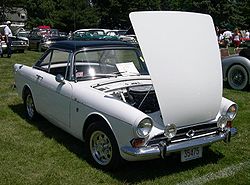Sunbeam Tiger: Difference between revisions
m robot Adding: de:Sunbeam Tiger |
|||
| Line 26: | Line 26: | ||
[[Category:Sports cars]] |
[[Category:Sports cars]] |
||
[[Category:Sunbeam vehicles|Tiger]] |
[[Category:Sunbeam vehicles|Tiger]] |
||
[[de:Sunbeam Tiger]] |
|||
Revision as of 21:33, 26 February 2007

The Tiger was a muscle car version of the Sunbeam Alpine roadster.
Rootes Group West Coast of America marketing director Ian Garrad realised that the Alpine's image was that of a 'touring car' rather than a sports car, and he set about changing its image, using the recent success of the Shelby Cobra as a guide. He and California sports car racer Doane Spencer measured up several V-8 engines and determined that Ford's new 164 hp 260 in³ Windsor V8 engine would fit nicely between the frame rails.
Sunbeam asked Carroll Shelby to produce one functional prototype on a budget of $10,000. Shelby's prototype was fabricated by Shelby employee George Boskoff, and the result was judged to be good enough to send to England for production evaluation.
For good measure, a second Series-2 Alpine was handed to Ken Miles. Ken Miles was an ex-Shelby employee, a talented racer and fabricator, and he managed to install a 260 cu.in. V8 and two-speed automatic into the Alpine in less than a week, at a total cost of $600. Ken Miles' prototype was kept by Rootes Motors Inc Los Angeles for some time and eventually sold to a private buyer.
After doing extensive engineering studies Rootes Group sub contracted development and pre-production testing to Jensen, located in Wolverhampton, England. Jensen Motors went on to manufacture the Sunbeam Tiger. Production reached 7,085 cars over three distinct series (the factory only ever designated two, the Mk1 and Mk2; however, since the official Mk1 production spanned the changeover in body style from the Series IV Alpine panels to the Series V panels, the later cars are generally designated Mk1A by current Sunbeam Tiger enthusiasts). MkII production totalled just 536 cars, and these Tigers, with the 200 hp 289 in³ engine, are rare today. Amazingly, both the Miles and the Shelby prototypes survive today, along with a number of other historically significant Tigers.
Production of the Tiger lasted from just 1964 until Chrysler purchased Rootes in June 1967. Chrysler could not be realistically expected to sell a car with a Ford engine, and Chrysler had no suitable engine to replace the Ford; Chrysler V8 engines all had the distributor positioned at the rear of the engine, unlike the front-mounted distributor of the Ford V8, making it impossible to fit the Chrysler engine into the Sunbeam engine bay without major, and expensive, revisions. Thus the Tiger was cancelled.
The Tiger enjoys significant popularity today as a classic sports car, with significant potential as a competition car in historic racing series.
In popular culture it is remembered as the car driven to work at "Control headquarters" by Maxwell Smart, during the opening credits of Get Smart.
The Tiger name was also used by Sunbeam on a completely different model in 1925. The 1925 Sunbeam Tiger was a V12 aero-engined racing car. Initially this vehicle was named Ladybird, but the name was subsequently changed to Tiger. Driven by Sir Henry Segrave it became the first car to exceed 150mph. A sister car to Tiger was built and named Tigress.
